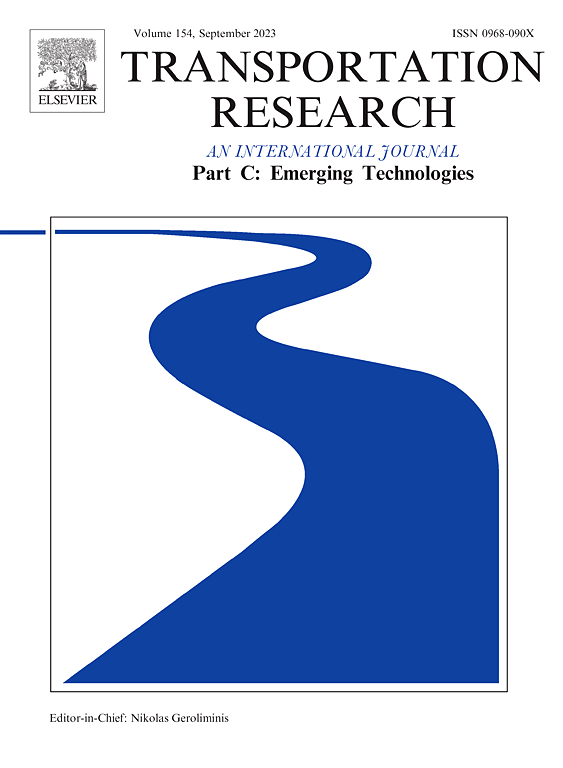Group-benefit control strategy for connected automated vehicles in mixed traffic at intersections
IF 7.6
1区 工程技术
Q1 TRANSPORTATION SCIENCE & TECHNOLOGY
Transportation Research Part C-Emerging Technologies
Pub Date : 2025-04-23
DOI:10.1016/j.trc.2025.105121
引用次数: 0
Abstract
The unpredictable driving behavior of Human-driven Vehicles (HVs) exhibits significant complexity when mixed with Connected Autonomous Vehicles (CAVs) and the periodic variations of the intersection signal phase impact the efficiency and stability of traffic flows. In response to these challenges, this study proposed a group-benefit driving behavior control strategy based on a Multi-Agent Deep Deterministic Policy Gradient (MADDPG) algorithm to provide comprehensive and overall efficient driving guidance for CAVs in multi-agent scenarios and reduce the impact of heterogeneous traffic flow on the signalized intersections. The dynamically encoded state enables the model to effectively adapt to dynamically changing environments, and each agent independently makes combined action decisions to achieve group benefits. Regularization methods and the attention mechanism are integrated to prevent overfitting and enhance stability, with the attention mechanism having a more significant impact. The results indicate that the model effectively reduces delays and fuel consumption even at low CAV Market Penetration Rates (MPRs), with the optimization effects significantly improving as MPR increases. Compared to the HV traffic flow, the optimized CAV traffic flow reduces average vehicle delay by 10.11% and CO2 emissions by 20.93%. The comparison with test models, which separately adjust traffic flow and signal phases, and interpolation experiments, which modify the MPR, demonstrates the model’s strong generalization ability and adaptability. Furthermore, compared with the Multi-Agent Deep Q-Network (MADQN) model, the proposed model demonstrates greater robustness with significantly better optimization results.
交叉口混合交通网联自动驾驶车辆群体效益控制策略
人类驾驶车辆与网联自动驾驶车辆混合时,其不可预测的驾驶行为表现出极大的复杂性,交叉口信号相位的周期性变化影响着交通流的效率和稳定性。针对这些挑战,本研究提出了一种基于多智能体深度确定性策略梯度(madpg)算法的群体利益驾驶行为控制策略,为多智能体场景下的自动驾驶汽车提供全面、整体的高效驾驶指导,减少异构交通流对信号交叉口的影响。动态编码的状态使模型能够有效地适应动态变化的环境,各智能体独立地进行联合行动决策,实现群体利益。将正则化方法与注意机制相结合,防止过拟合,增强稳定性,其中注意机制的影响更为显著。结果表明,该模型在低CAV市场渗透率(MPR)条件下也能有效降低延迟和燃油消耗,且随着MPR的增加,优化效果显著提高。与高压交通流相比,优化后的CAV交通流平均减少了10.11%的车辆延误,减少了20.93%的二氧化碳排放。通过与分别调整交通流和信号相位的试验模型和修改MPR的插值实验的对比,证明了该模型具有较强的泛化能力和适应性。此外,与多智能体深度Q-Network (MADQN)模型相比,该模型具有更强的鲁棒性,优化结果明显更好。
本文章由计算机程序翻译,如有差异,请以英文原文为准。
求助全文
约1分钟内获得全文
求助全文
来源期刊
CiteScore
15.80
自引率
12.00%
发文量
332
审稿时长
64 days
期刊介绍:
Transportation Research: Part C (TR_C) is dedicated to showcasing high-quality, scholarly research that delves into the development, applications, and implications of transportation systems and emerging technologies. Our focus lies not solely on individual technologies, but rather on their broader implications for the planning, design, operation, control, maintenance, and rehabilitation of transportation systems, services, and components. In essence, the intellectual core of the journal revolves around the transportation aspect rather than the technology itself. We actively encourage the integration of quantitative methods from diverse fields such as operations research, control systems, complex networks, computer science, and artificial intelligence. Join us in exploring the intersection of transportation systems and emerging technologies to drive innovation and progress in the field.

 求助内容:
求助内容: 应助结果提醒方式:
应助结果提醒方式:


